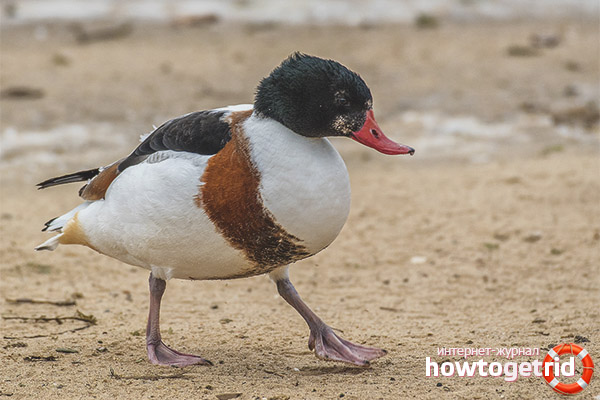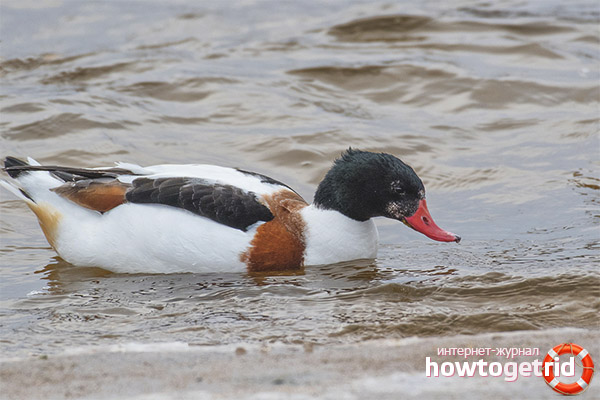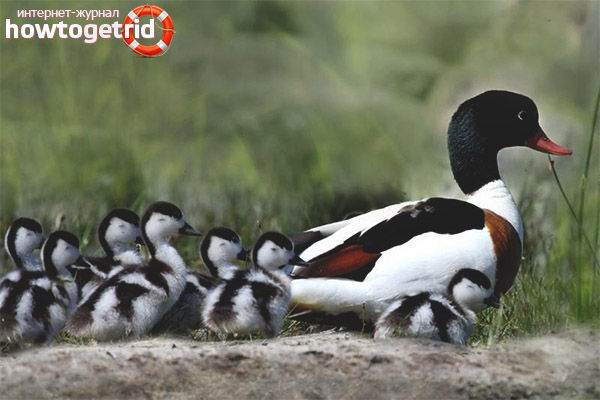The content of the article
The pegans duck is of unusual interest to hunters, because it is a very valuable trophy. People living everyday life are also interested in this breed of feathered.
The extremely bright color and large size of the bird attract the eyes of most hunters from around the world. In the wild, 2 huge populations of these ducks are distinguished:
- living on salt lakes;
- found in the steppe zone of southern Russia.
There is a high probability of encountering Peganu on the same rivers as the Elbe and Weser, flowing in Germany, as well as in many bays in the UK. Currently, birds feel good on the shores of the Black and Azov Seas in Ukraine, however, the largest population is located on the territory of Russia, where their number reaches 100,000 individuals. Some populations captured the coastal and steppe territories of Turkey.
In Australia and New Guinea, pegans are officially protected by the authorities. In these countries, it is strictly forbidden to export them from the continent.
Pegan breed general information
The birds got this name due to the unusual color for birds, which is called "piebald". This breed is considered one of the oldest in the world, they are characterized by primitive genetic traits. Residents of Crimea gave the bird the name galagaz. Nature endowed them with a large body, measuring up to 65 cm in length, and a wingspan greater than 1 m. Adult ducks are characterized by a weight of 0.8 to 1.5 kg.
Currently in the world there is a division into the following varieties among pegans:
- peganka raja;
- ordinary;
- extinct crested.
- sedentary;
- migratory;
- partially migratory.
An interesting fact is that these birds live in colonies, but nest at the same time at a considerable distance from the water. There are cases when they occupied burrows in which the fox had previously lived. It is popular among birds because predators very rarely hunt near their place of residence.
Pegans are among the large birds. In the event of danger, the ducks create a noise that the entire flock instantly rises to. Such is the protection of egg laying against uninvited guests, of which they have a lot. Many animals want to feast on eggs from the nest of pegans, among all wild cats, otter, jackals. Even kites can harm ducks.
Breed features
Due to their large size and the presence of a long neck, they are sometimes compared with geese. The paws of the bird are also elongated, thanks to which it moves very quickly and dexterously on land. This comparison is also taken according to how the process of flight takes place, during which they rather slowly flap their huge wings to balance in space. Many often confuse ducks and geese among themselves.
During flights, they line up in the shape of a wedge. Before migrating to the shores of Germany and England, Pegasus ducks are combined in flocks. The beginning of molting coincides with this period in them. At the same time, males are the first to appear, the number of which is huge, and only after a short period of time the females arrive. An interesting fact is that during the period of the appearance of new plumage in birds, they do not have the opportunity to rise into the air.
Peggirls during the courtship conduct a unique ritual in the final scene of which they ceremoniously worship their female. This is an unusually beautiful sight.
Appearance of birds
Often the body of the bird has white feathers. Females and males of pegans breed have almost the same appearance. Marks of chestnut color adorn the chest of the bird, and the shoulder blades have a black stripe. An orange ribbon runs across all shoulders, as well as the sides and abdomen, which is wide from the back of the neck to the base of the wings.
The feathers are black in color, but in secondary feathers, the external webs have the property of folding in the mirror. The pegans' undergrowth has an orange-red hue.
Birds have pink legs and bright red beaks, as well as black heads with a green tint. And all this exotic look is emphasized by the red-brown iris of the eyes.
In order to visually distinguish a duck from a drake, you should look at its color, which will be a little dull than that of a drake. They also lack a growth on the beak and malachite mirrors on the feathers of the wings. You will not see the white “eyeliner” around the eyes, which is inherent in males.
Despite such a unique appearance, the population is not a rare species, so hunting for them is allowed. Currently, their number totals up to 7.1 million individuals.
This breed of ducks changes its feathers twice a year. After the summer shift, they do not look so bright. Initially dressed in buffy-brown feathers on the head. As for the color of young birds, it resembles females. A distinctive feature is snub-nosed beaks and the complete absence of green overflow.
Penguin breeding
As soon as the first thawed spots appear on the water bodies, and this is the end of March - the beginning of April, the duck nesting process begins. The construction phase of the nest is completed around July. There are cases when they nested in the hollows of tree trunks, as well as in structures that were made by man.
It is interesting that males acquire the ability to conceive only only in the 4th year, and females are twice as fast - in the 2nd year of life. Species of ducks that are migratory begin to search for a pair in winter, and those that are considered settled are at the first sign of heat.
A pegany can lay up to 10 eggs that have the same creamy shell color. The egg hatching period takes approximately 28-30 calendar days in females.
In order to attract the attention of a female, the male extends its neck and produces unique screams. Drains are multifaceted individuals, they cope with all the responsibilities of the father during the period of the hatching process, which takes about a month. They never leave for long distances the nest where his female remained; they constantly protect her from any dangers.
If the duck needs to move away from its nest, then with neatness and extraordinary care, it covers the eggs with fluff, which is located next to the nest. It should also be noted that fluff is always abundant.
Raising little ducklings
Pegans who have just hatched from an egg are large and can swim right away. Not only that, they can easily dive in search of food, but for adult individuals this behavior is not inherent. There are cases when several families united in raising children, creating joint protection.
The chicks, which have already grown a little, fall under the universal supervision of the whole flock. After a month and a half, they begin to try to fly. After acquiring the skill to conquer airspace, they begin an adult independent life.
Interestingly, the pairs that are created by pegans ducks last for their entire lives.There are cases when ducks nested on slopes that are located high and far from the water. In such cases, in order for the chicks to be in the water, the parents carry their chicks with their beak.
Naturalist lovers who watch the birds many times noticed a picture of touching caring for their offspring, when the duck was the first to walk, and then the ducklings chased her and the father of the whole family walked behind everyone, who carefully looked around to find danger.
Pegans nutrition
The bird prefers various mollusks and all kinds of worms. They do not refuse small fish and crustaceans, which are easily caught. Snails on their way not only enter the diet, but are also their favorite food. At the opening of one dead pegans, more than 3,000 snail shells were found in her stomach.
In winter, when hunting for fish and crustaceans is difficult, it can feed on vegetation. Food is obtained with the help of a large beak, which nature has awarded unique birds. There are cases when a bird left a pond and ate in the fields with seeds and different fruits.
The best time for feeding is considered to be the low tide, because on the shore, where the water left, there remains a huge number of animal organisms that are stuck in the bottom. During this period of time, they stay on the water surface and with the help of an elongated long neck begin the search for food.
Hunting ducks is best in the autumn, because at that time they have already gained weight. In order to beat off the specific smell that is inherent in wild meat, hunters wrap the plucked carcass in a cloth and bury it in clay. This is done thanks to the excellent absorbent effect. Some lovers of hunting for these beautiful ducks do not attribute the meat to very tasty, but produce the extraction process only in sports interest.
Pegans behavior
Separating the breed of birds on settled, migratory and partially migratory, they occupy different areas for their living. It does not apply to fearful breeds, therefore it calmly allows a person to approach it at close range. It is considered an unusually sociable bird.
Pegans are known for their unusual voice, and legends circulate about male vocal performances. During the search period, the males begin to emit high-frequency sounds that very much resemble a whistle. It is interesting that they can do this even when they fly in the air in pursuit of a female.
But the females do not have such skills, they are characterized by the pronunciation of "gaga ..", which they can repeat many times and in a split second. In case of danger, she screams very loudly, trying to scare offender. It should also be noted the aggressiveness of the female during the period of rearing chicks, when they can even drive their relatives away from their babies.
There are cases when a female pegans hatched up to 32 eggs. This happened due to the fact that they can lay their eggs in other people's nests. This is a very common occurrence for this breed of ducks.
Pegans migration
For those individuals who lead a migratory lifestyle, a change of place of residence occurs three times. The first flight takes place at the place where they are molting. After the feather has strengthened, and the birds have the opportunity to fly into the air, they gather in flocks and make a second flight.
This flight is called autumn migration. It passes approximately in September-October. And the final flight is the return to the nesting places in the spring.
Video: peganka (Tadorna tadorna)













Submit